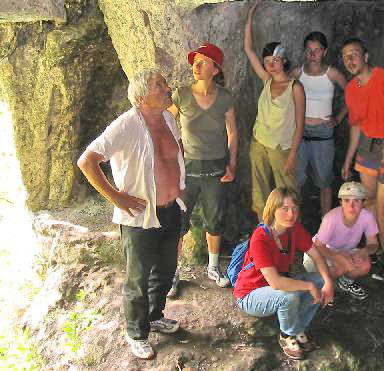Turkic Cave Temple on the Dniester River Bank
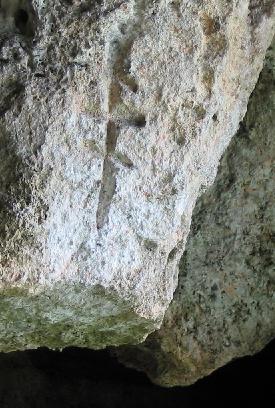
In 1988 the ecological expedition "Dniester" of Lion Society (the city of Lviv) found a karst cave on a steep left bank of the Dniester River near the village of Stinka in Buchach district of Ternopil Region. It was located at an altitude of 12-15 meters above the water and being accessible aroused a great interest of researchers. A stream flowed through the cave and eroded its floor over time, it largely changed its original appearance and made it difficult to enter.
No doubt, the cave interior has been processed by human hands. This was more obvious because its walls had visible carved-in stone signs of pagan and Christian symbolism. In particular, at the entrance to the cave, an Orthodox cross was carved on a broken stalactite. An examination of the cave showed that it was not intended for habitation and its interior was created for a specific purpose. The archaeologist Vadym Artiukh suggested it was an ancient pagan structure, later reworked into a Christian chapel.
Getting home in Lviv, he began to study the theme of early religious temples on the Dniester banks and the surrounding areas and would be continuing this issue during the next annual expeditions "Dniester". As it turned out, there are enough religious structures near the Dniester River. Collected by V. Artiukh material and results of previous researchers to "organize, classify pre-Christian religious sanctuary and share them according to architecture into some categories"[ARTUIKH VADIM, 2006: 1]
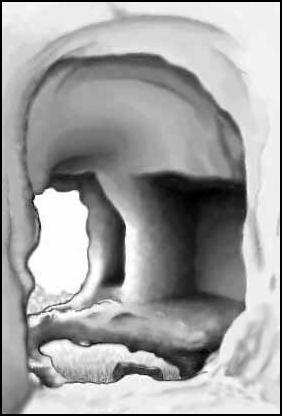
Right: Interior of the cave sketched by Andriy Kviatkovsky. 1994 .
Among rock-cave religious structures, the cave in Stinka occupies a prominent place. Under the leadership of V. Artyukh, it was repeatedly explored by members of the Dniester expedition, who made their sketches of images on the cave walls. Such sketches have been made more than once, but they are somewhat different because the carved signs are distorted by unorganized visitors, who have become more numerous in recent years.
Description of the caves and signs were recorded in reports records of the expedition "Dniester" for 1990-91. This material was used by V. Artiukh when writing his work:
The temple in horizontal projection has a trapezoidal shape with the entrance on the west side, with an altar and two porches in the form of niches in the eastern part.
Carved signs are preserved on the walls of the temple and inscriptions are made with a sharp instrument. There is an image in the center of the chancel seen as an equilateral cross of the Greek type, but more resembled a swastika of 30x30 cm. The vertical element has bifurcated ends and the horizontal ends are bent.
There is on the sidewall of the altar a sign in the form of a vertical rectangle dissected in the middle. A barely visible inscription of five signs of poor preservation can be seen below the swastika. But you can see that the first sign reminds digit 4, the second lattice does, the third is like a loop, and the fourth and fifth have a mushroom shape.
An inscription of six characters is also made on the west wall. The first and fourth characters resemble figure 4, and the second and fifth have loop shape characteristics for tamga signs, with one end rounded, and the other bent at an angle. The third sign is shown in the form of strokes, tapering downward angle, and connected to a transverse line, the sixth reminds the letter H. The following two characters K and P are viewed below.
An image of a cross with expanded ends is preserved on the north side of the temple. Near the sign is depicted as a tree with two branches, one of which is rounded.
At the entrance on the north wall, there are graphic images of Greek, St. Andrew's, and Orthodox crosses, as well as a sign in the form of reverse letter F and a sign consisting of geometric shapes: square at the top and an equilateral triangle shown top-down" [ARTUIKH VADIM, 2006: 8-9].

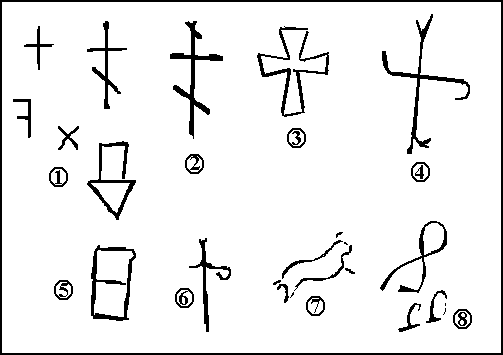
A scheme of the cave rooms with designated signs on the walls and signs themselves, which places in the cave are designated by numbers.
These signs were also photographed by Alena Krushinskaya in 2004, some of them are given in the photo below.
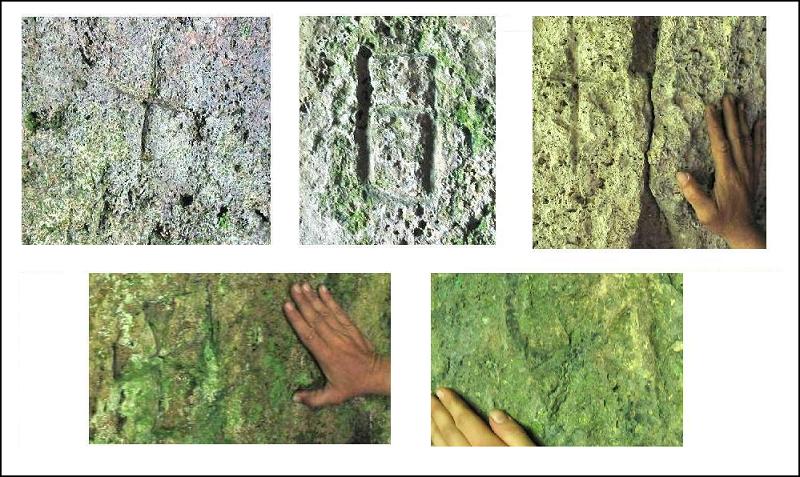
Of particular interest are the inscriptions carved on the walls. Their original sketches in several versions are in the archive of the expedition "Dniester". Below are copies of one of them in two ways.

Sketches of the same inscription. Left – made by Borys Ivankov in 1991, made the right made by Volodymyr Backus in 2004.
Comparison of the signs of these inscriptions with known writing systems revealed a striking similarity of most signs in the cave of Stinka with Turkic and, in particular, Proto-Chuvash runes. Orhon–Yenisei's runic characters were deciphered by Danish scientist V. Thomsen. They echoed Old Chuvash's runic writing studied by A.A. Trofimov. I cannot get his book "Old Chuvash runic writing" (Cheboksary, 1993) but I found 132 runic signs in the article "The Bulgarian runes" on Wikipedia collected by Bulgarian researcher P. Dobrev based Proto-Bulgarian (Proto-Chuvash in our terminology) inscription in the village Murfatlar (North Dobrogea), on the walls of the first Bulgarian capital Pliska and elsewhere. He proposed decoding based on the erroneous assumption Iranian language of the Bulgarians, so it falls, the more that we're talking only about the origins of characters, rather than reading them. Dobrev's table of signs is presented below .
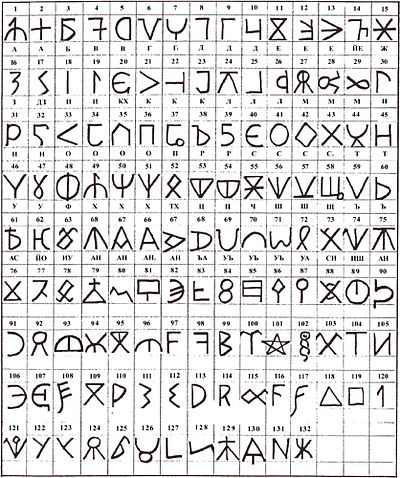
If the signs of the cave of Stinka compare with Dobrev's signs, almost every one of them can have a match in the table, marked in blue. The similarity of the signs, such as a square, triangle, or square cross can be explained by their simplicity, which could be the reason for their use in different writing systems, but the original mark in the form of a loop repeatedly repeated in the cave also has several options in the table. A sign similar to the letter P is in fact also a loop, as it is seen in other sketches. This sign is quite common in different writing systems, in particular, it can be found in Germanic runes. V. Artiukh noted that this sign "was recorded at the shard of Chernyakhiv culture with near the village of Bakota" [ARTIUKH VADYM, 2006, 19 ]. Mentioned by him the sign in the form of mirroring the letter F is also present in Dobrev's table.
In the valley of the Molochna River in the Zaporizhzhia region of Ukraine, there is a natural monument called Stone Tomb. It is an isolated array of sandstone with several dozen caves, on the walls of some of which there are many petroglyphs, both figures and symbols. Some of the petroglyphs date back to the XXIV-XXII centuries BC. They (in particular in the photo below) can find correspondences in the runic signs of Dobrev's table (in red squares).
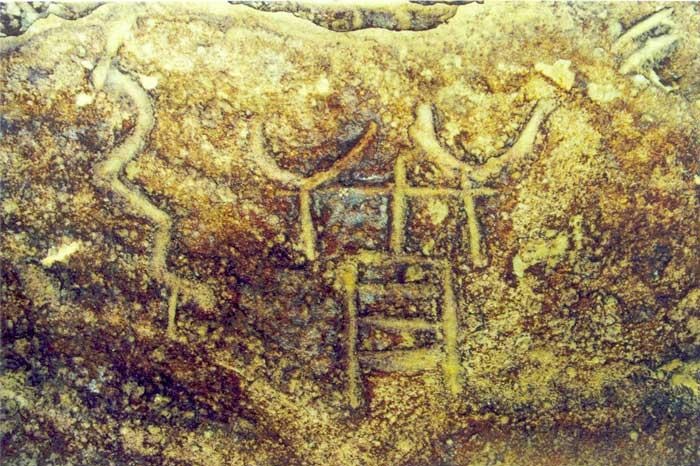
At right: "The team of bulls" on the panel number 37. Stone Tomb. (MYKHAILOV BORYS. 2003).
At the indicated time in the valley of the Molochna River there were settlements of distant ancestors of modern Chuvashes (see section The Türkic Tribes). In this connection, the similarity of the ancient Chuvashian runic signs to petroglyphs on panel No. 37 of the Stone Grave may not be accidental. Researchers believe that the panel in a symbolic-symbolic manner (extremely stylized) depicts a team of bulls (DANYLENKO V.M. 1986: 67; MYKHAILOV BORYS. 2003). However, on the same panel, other bull teams are depicted realistically, so you can regard the petroglyph as an image of signs.
Another set of Old Chuvash runes is given without specifying the source on the site "The country of hundred thousand songs" of Sverdlovsk regional ethnic library. Two upper rows are Old Chuvash runes, sketches of characters from the cave of Stinka are below.
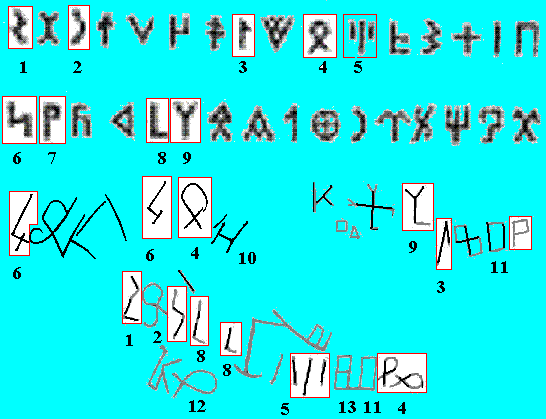 s
s
The similarity of the signs from the cave to some runes gives grounds to conclude that the inscription in the cave was left by the Protochuvashi. (For convenience, these signs are numbered and placed in red frames).The matches to another sign of the cave you can find on Dobrev's table.
Some signs of caves have a sacred sense. In particular, this can be said about the signs and swastikas in the form of a tree, mentioned by V. Artiukh. The swastika represents the sun sign, and the image of the tree symbolizes Tree of Life . Signs of the Sun and Tree of Life are typical for the Chuvash sacred symbolism. How the outlook of the Tree of Life is important for the Chuvash, can be confirmed by the fact that it has become the main element of the new state symbols of the Chuvash Republic – emblem and flag.
Evidence about the presence of the Proto-Chuvashes in western Ukraine we have seen repeatedly (see sections Ancient Turkic Place Names in Eastern Europe and Chuvash-Germanic Language Connections). Now we can talk about the similarities between Old Chuvash's runic writing and with writing of Germanic peoples. Below is a set of Gothic runic characters, some of which are similar to Proto-Chuvash ones.
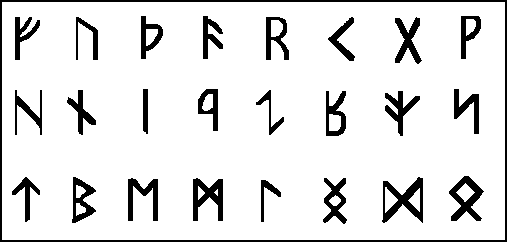
Germanic runic writing systems having similarities are quite different themselves, but they also have many common characteristics. German scientist Theo Vennemann, considering the origin of the Germanic runic writing, disputes the common view on its development of Latin letters and argues that the ancient Germanic peoples developed it directly from the Phoenician alphabet. As Phoenicia is located very far from the territory of the Germanic settlements in Central Europe, he explains borrowings by contacts of Germanic peoples with the Phoenician colony of Carthage in Africa. [VENNEMANN THEO, gen. Nierfeld, 2012: 530 – 580]. The difference between Germanic and Phoenician letters is usually explained by the fact that the Germans carved texts on the tree so it was difficult for them to display horizontal and rounded lines, and T. Vennemann agrees with this (ibid, 537-538).
Only specialists could judge how Vennemann's arguments are convincing, but if the Germanic letter is based on Phoenician writing, the easiest way of borrowing would be from Trypillians, whose origin may be Semitic, at a time when the Germans were still in Eastern Europe. When Proto-Chuvashes could be intermediaries.
And now we will try to decipher the inscription on the central altar of the temple, which is reconstructed from the made sketches. Its foreseen is shown on the left.
We see that the first two characters are similar to the last two ones. If the inscription was made in the Proto-Chuvash language, then according to the law of open syllables, the second and final signs shall be vowels if the word begins with a consonant, which is most likely (in the Chuvash language overwhelming number of words begin with a consonant). The first sign in the shape of Ч is identical to the character referring to the sound d in Dobrev's table. In the modern Chuvash language, close to that sound is reflected by the letter t (letters for the sound d are absent). Then the inscription in the modern Chuvash writing would have the form t8??t8, where 8 – any vowel sound and the remaining two other sounds remain in question. It was nothing better found in the dictionary of the Chuvash language [SKVORTSOV M.I. (Ed.) 1985] as stable word combination tupatu "to take an oath". This inscription is very suitable for the altar. The custom "tupa tu" to give the oath of loyalty before marriage is kept among Chuvash till now.
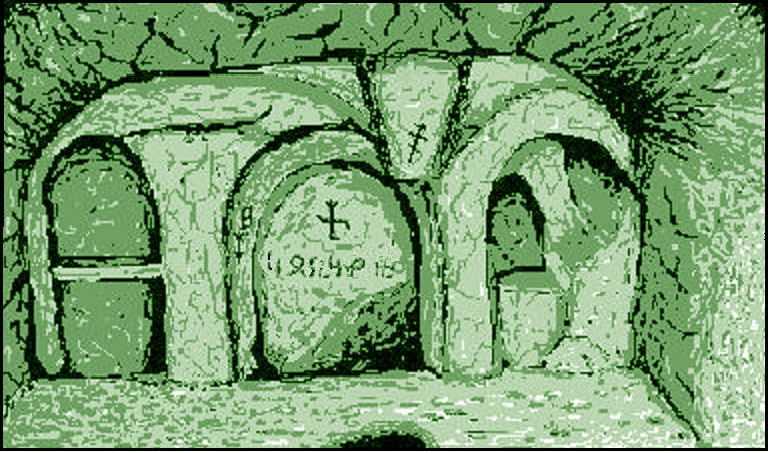
At right: The interior of a Proto-Chuvash cave sanctuary on the Dniester River near the village of Stinka. The sketch of the Valentyn Stetsyuk. 1989.
Thus, not only found further evidence of the stay of the Proto-Chuvashes (Scythians) in Western Ukraine but also direct evidence that the custom of the Chuvash "tupatu" dates back to the Scythian goddess of the hearth Tabiti. She corresponds to chaste Greek Hestia, the goddess of a home. Her chastity is precisely reflected in the Chuvash expression tupa tu “to take an oath”, which could mean “taking a vow of celibacy”. Also, Karachay-Balkar women take an oath of allegiance during marriage with a similar word “Tobady!” (LAYPANOV K.T., MIZIEV I.M. 2010: 43). For more details see Scythian Mythology).
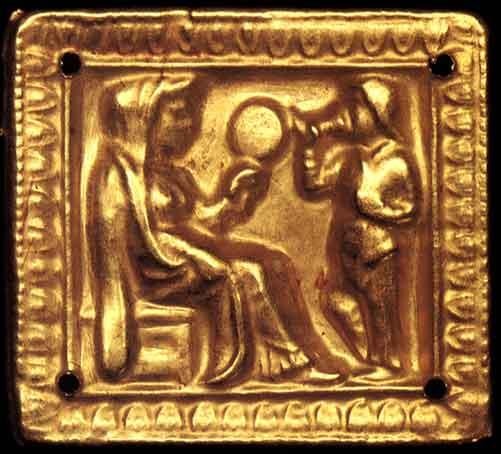
At left: Scythian goddess Tabiti with a mirror in her hand . Golden plaque from the mound Chertomlyk.
Dmitry Rajewski, considering the image of the goddess Tabiti in connection with the Greek Hestia, interprets Herodotus' words about especially sacred oaths of the Scythians (τάς βασιλτηίας ίστίαζ) as an oath "royal Hestias", that is the oath by the name Tabiti (RAYEVSKIY. 2006, 65). He also explains the presence of the mirror in her hand by the existence of ritual weddings and other ceremonies related to marriage, in which a mirror is present as an essential traditional attribute (ibid. 73). As you can see, the modern Chuvash tradition is directly linked to the custom of the Scythians.
It is interesting to note that in the village of Stinka, as well as in several other Carpathian villages along the Dniester, live believers of the Amish religious sect, who voluntarily abandoned the comforts of civilization – electricity, water and gas supply, telephones, television, computer, even watches. Their faith forbids serving in the army, taking pictures, and driving a car. One might think that such a coincidence is not accidental and that the pagan tradition among these people has coexisted for centuries with the Christian faith.
Description of the temple in graphics.


